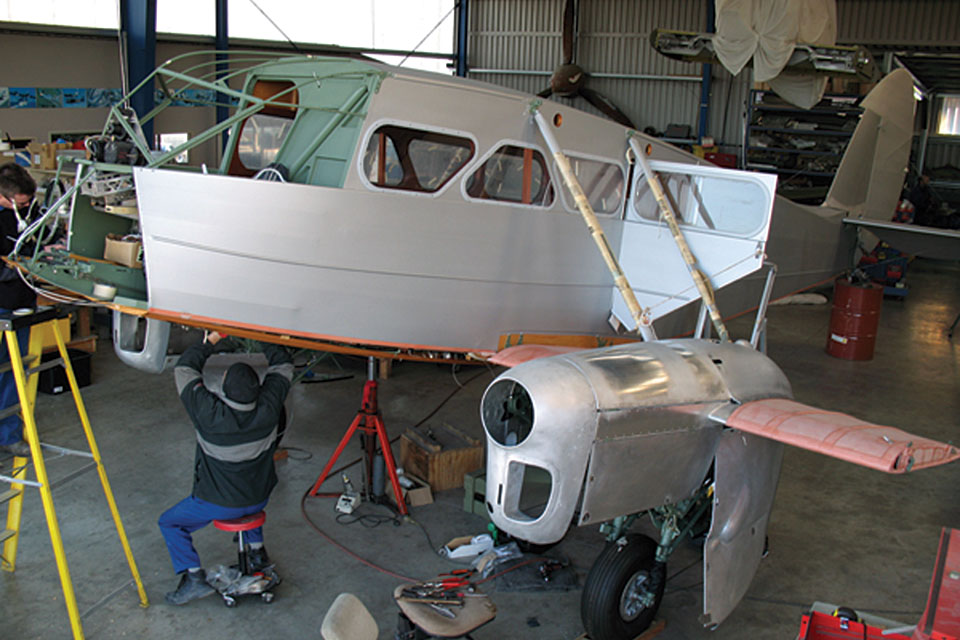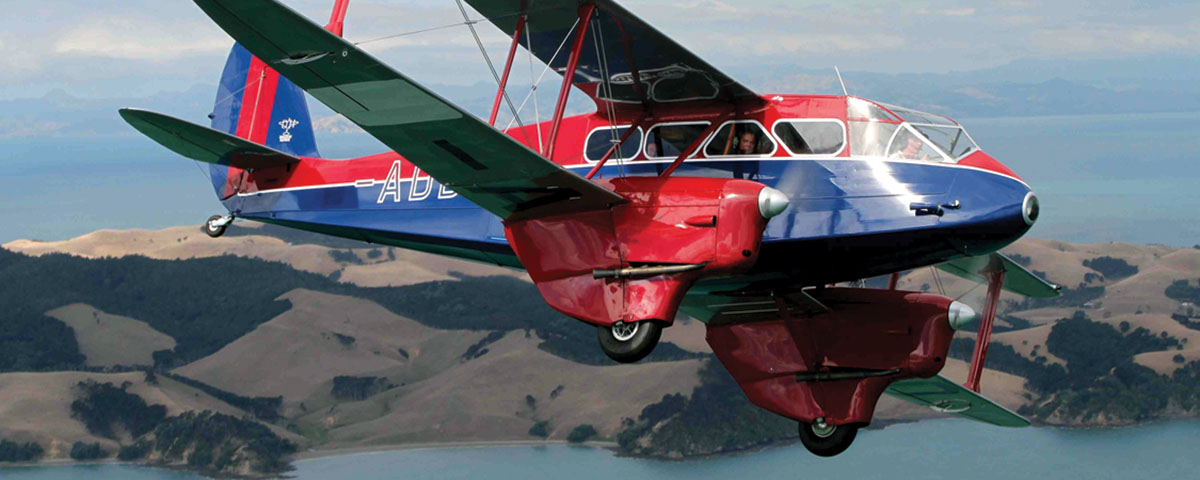A touch of royal elegance graces the skies over Virginia Beach.
On March 21, 2010, a blue and red de Havilland D.H.89A Dragon Rapide, piloted by Dave Phillips, took to the sky from Ardmore Airport near Auckland, New Zealand. Comprehensively rebuilt to the exact specifications of the original by Avspecs Ltd., which specializes in restoring classic aircraft, the biplane transport would ultimately be headed for the United States.
At the time, arguably the oddest thing about the wooden aircraft was that one of the large civil call letters on its side was missing. When Gerald Yagen, of the Military Aviation Museum in Virginia Beach, Va., bought the de Havilland, its vertical stabilizer bore the American civil registration NX89DH. At Yagen’s request, however, the plane was decked out in the markings of a Rapide purchased in 1935 by Edward, Prince of Wales, with the colors of the Royal Guards and the call letters G-ADDD. When it came to flying around in New Zealand’s airspace, however, the authorities deemed it too confusing to have an airplane with an American registration on the tail and the “G” of Great Britain on the fuselage. So Avspecs simply covered over the G for its test flights, uncovering it when the plane was delivered to its owner in the States.
The D.H.89 was the culmination of an evolution that began in April 1933, when the D.H.84 Dragon, powered by twin 130-hp Gipsy Major 14-cylinder engines, entered service flying six passengers with 45 pounds of baggage each. Although 115 were built, de Havilland and the airlines that operated the Dragon sought to improve its performance. One follow-up was the D.H.86 Express, using four engines and a new elliptical wing, but it suffered from handling problems. Nevertheless, when Hillman’s Airways Ltd. issued a requirement for an airplane capable of carrying six passengers from London to Paris in some degree of comfort, de Havilland developed a scaled-down version of the Express powered by twin 200-hp Gipsy 6 engines in streamlined fairings.
The prototype first flew on April 17, 1934, and this time everything fell into place. The D.H.89 Dragon Rapide was an elegant-looking transport that could carry eight passengers up to 573 miles. With a top speed of 157 mph and a ceiling of 16,700 feet, it was the most successful British short-haul passenger aircraft of the 1930s. A total of 205 were built before 1939. Improved trailing edge flaps were introduced in the D.H.89A in 1936.
“The surprising thing about this airplane is how much it will carry,” said Warren Denholm of Avspecs. “It will carry as much as a Beech 18 on two 200-hp engines, and [the Beech 18] has 900 hp. It’s remarkable what it will do on such low power. Of course, it doesn’t do it very fast.”
Although built primarily of plywood, the biplane proved to be remarkably durable. During World War II it gave Britain a short-haul transport and trainer that freed up metal for more critically needed warplanes. In consequence, production continued on Rapides for the Royal Air Force, including the D.H.89B Dominie, using improved Gipsy Queen VI engines, which was built as the Mark I wireless and navigation trainer, and the Dominie Mark II light transport. Ultimately, 731 Dragon Rapides of all variants were built—more than two-thirds of them during World War II.
The D.H.89A that caught Jerry Yagen’s eye was one of those wartime planes, among 75 built under an RAF contract in 1944 at Brush Coachworks Ltd. of Loughborough. That March it was delivered to the 18th Maintenance Unit at RAF Dumfries, Scotland. In February 1947, the 5th Maintenance Unit placed the Rapide in storage until Newman Airways bought it in August. The airline used it to make two or three round trips each weekend from Croydon to the Channel Islands of Jersey and Guernsey.
Transferred to Midland Metal Spinning Company Ltd. in Wolverhampton on March 13, 1951, the D.H.89A was sold to Aer Tura in Dublin, Ireland, which operated it from 1962 to 1964. The transport was acquired in 1965 by the Aero Club de Lorraine at Lunéville, France, later going to the Centre École Regional de Parachutisme Sportif de Nancy-Lorraine in 1968. After its French registration was canceled on November 27, 1972, the aircraft was imported to the U.S. by Geert E. Frank of East Kingston, N.H., and sold again in November 1973 to Doyle W. Cotton Jr. and W.F. Watson. They registered it as N89DH in 1982 and painted it as X7454 of the 27th Air Transport Service, Eighth Air Force, for Cotton’s private museum in Broken Arrow, Okla. His collection was auctioned off in October 1987, and Robert C. Hood of Joplin, Mo., bought the Rapide for $75,000.
When Yagen found it in April 2007, N89DH was in a hangar at a former airfield that had been converted to an industrial park. “It was left to go to rot and ruin for many years,” according to Military Aviation Museum director David Hunt, “until it was bought by Jerry Yagen and restored by Avspecs. They’re experts at working with wooden planes, having done a lot for us, including the de Havilland Mosquito that is nearing completion.”
As part of the purchase agreement, Yagen acquired three Gipsy Queen III engine cores, so he had enough parts to rebuild two working engines. Some 75 percent of the airframe’s components had to be replaced outright. “Because it’s all wood, it’s built more like a boat than an airplane,”Yagen explained.

“We had to build a new fuselage because the wood was pretty degraded, but the wing woodwork was pretty good,” reported Denholm, who began the restoration project in January 2007. Even so, a wing had been damaged on one side. “The repairs were not up to standards,” he said,“so we spliced a new wingtip on.”
Unlike most airliners of its time, the Dragon Rapide had no copilot; its cabin narrowed to accommodate a single pilot’s seat. A new control panel was installed there, along with the inevitable concession to modern flight requirements: up-to-date avionics.
Considering all the wear, tear and neglect the plane had endured, Yagen is quite satisfied with his fully restored transport. “The de Havilland Rapide is very close to the original condition,” he said, “maybe except the glossy paint job.”
“In its time it was the Learjet of airplanes, at least in the 1930s,” Denholm pointed out. “If you had one of these you really had made it, and that was evidenced by the fact that the royal family had them.”
“I provided them with the color scheme and interior details,” British aviation writer and publisher Graham Simons said. “They have done a good job of a representation of Triple D!” Among the interior touches were red seat cushions bearing the trefoil feathers of the Prince of Wales’ coat of arms. After flying the plane in 1936, the prince reigned— briefly—as King Edward VIII. Mostly remembered for abdicating the throne in order to marry divorcée Wallis Simpson in 1938, Edward also rates a footnote in aviation history as the first British monarch to be a qualified pilot.
After its flight test at Ardmore, the Dragon Rapide was dismantled and shipped in a 40- foot cargo container to Virginia Beach. Following its first flight there in May 2010, it went on to win Best Transport at EAA AirVenture in Oshkosh last summer.
Originally published in the September 2012 issue of Aviation History. To subscribe, click here.





